
About UsThe Numismatic Bibliomania Society is a non-profit association devoted to the study and enjoyment of numismatic literature. For more information please see our web site at coinbooks.org SubscriptionsThose wishing to become new E-Sylum subscribers (or wishing to Unsubscribe) can go to the following web page link MembershipThere is a membership application available on the web site Membership Application To join, print the application and return it with your check to the address printed on the application. Print/Digital membership is $40 to addresses in the U.S., and $60 elsewhere. A digital-only membership is available for $25. For those without web access, write to: Terry White, Treasurer AsylumFor Asylum mailing address changes and other membership questions, contact Terry at this email address: terrywhite5475@yahoo.com SubmissionsTo submit items for publication in The E-Sylum, write to the Editor at this address: whomren@gmail.com BUY THE BOOK BEFORE THE COINSale Calendar |
- WAYNE'S WORDS: THE E-SYLUM FEBRUARY 20, 2019
- NEW BOOK: ENGRAVERS, MINTERS OF CIVIL WAR TOKENS
- NEW BOOK: THE COINS THAT SHAPED BRITAIN
- COIN ALBUM CHECK LIST AND VALUE GUIDE AVAILABLE
- NUMISMATIC NEWS EDITOR DAVE HARPER RETIRES
- NNP ADDS BOWERS & MERENA AUCTION CATALOGS
- SEEKING (BUT NOT FINDING) JOSH TATUM
- MORE ON THE MUGHAL MULTIPLE-MOHUR COINS
- NOTES FROM E-SYLUM READERS: FEBRUARY 17, 2019
- B. MAX MEHL MEMORABILIA
- VOCABULARY TERMS: CHALK AND TRANSFER WAX
- JOHN CHARLES SCHAYER (1837-1907)
- ARTICLE PROFILES DEALER ELIZABETH COGGAN
- 2019 NATIONAL MONEY SHOW WELCOME BANQUET
- SS CENTRAL AMERICA CASH BOX FINDS
- EXPERT-LEVEL U.S. MEDALS CHALLENGE
- NUMISMATIC NUGGETS: FEBRUARY 17, 2019
- WAYNE'S NUMISMATIC DIARY: FEBRUARY 17, 2019
- HEATON MINT SPECIMEN 5 CENT
- 1937 "REEDED EDGE" NICKEL AND CENT
- THIRTY-SIXTH ANNUAL COIN OF THE YEAR AWARDS
- LOWELL NATIONAL HISTORICAL PARK QUARTER LAUNCH
- PITTSBURGH AMUSEMENT PARK TOKEN HEADS TO MOON
- PHIL MICKELSON'S SILVER DOLLAR BALL MARKER
- SPRING VALLEY ILLINOIS NATIONAL BANK NOTE
- DOLLAR BILL ALTERED INTO A $100
- VALENTINE'S DAY WITH BANKNOTE BOUQUETS
- ART FROM VENEZUELAN BANKNOTES
- THE ART OF BOOK COVERS
- LOOSE CHANGE: FEBRUARY 17, 2019
- KIDS TODAY: WHAT IS CASH?
Click here to access the complete archive
To comment or submit articles, reply to whomren@gmail.com
Content presented in The E-Sylum is not necessarily researched or independently fact-checked, and views expressed do not necessarily represent those of the Numismatic Bibliomania Society.
WAYNE'S WORDS: THE E-SYLUM FEBRUARY 20, 2019
 This week we open with two news books and a value guide, the retirement of a longtime U.S. numismatic editor, a
major addition to the Newman Numismatic Portal, and a search for Josh Tatum of "Racketeer Nickel" fame.
This week we open with two news books and a value guide, the retirement of a longtime U.S. numismatic editor, a
major addition to the Newman Numismatic Portal, and a search for Josh Tatum of "Racketeer Nickel" fame.
Other topics this week include dealers John Schayer, B. Max Mehl, Jim King and Liz Coggan, the SS Central America cash box, the 1937 "Reeded Edge" cent and nickel, the Lowell quarter launch, and banknote artwork.
To learn more about the coins that shaped Britain, German inflation tokens, double-stuf quarters, transfer wax, the "King of Alligators", the 2019 Pittsburgh National Money Show welcome banquet, the Columbian Half Dollar "Opium Coin", Lou Gehrig's Elks membership medal, Tumbled Ormolu, the 18 3/4 cent note, and valentine's day banknote bouquets, read on. Have a great week, everyone!
Wayne Homren
Editor, The E-Sylum
NEW BOOK: ENGRAVERS, MINTERS OF CIVIL WAR TOKENS
Dave Schenkman was the first to submit information about this new title by Q. David Bowers. Thanks! -Editor
 Engravers, Minters, and
Distributors of Civil War Tokens is a recently released book by Dave Bowers. Published by the Civil War Token Society, the 264 page hardbound
book is available for $19.95 which is a bargain. However, if you want an even better bargain, the members' price is only $5 for shipping. Dues in
CWTS are $18, so why not send $23 - you'll receive the book and become a member. Additional details are available on the CWTS web site:
cwtsociety.com.
Engravers, Minters, and
Distributors of Civil War Tokens is a recently released book by Dave Bowers. Published by the Civil War Token Society, the 264 page hardbound
book is available for $19.95 which is a bargain. However, if you want an even better bargain, the members' price is only $5 for shipping. Dues in
CWTS are $18, so why not send $23 - you'll receive the book and become a member. Additional details are available on the CWTS web site:
cwtsociety.com.
In my opinion this book belongs in the library of every collector of nineteenth century tokens. It provides a wealth of information on token makers not available elsewhere.
What a great deal! I'm a CWTS member so I ordered myself a copy. I'm really looking forward to it. Dave Bowers been working on this one for some time, and it's been eagerly anticipated. These makers produced more than just Civil War Tokens, so as Dave Schenkman says, it's a wealth of information for just about any collector of U.S. tokens. -Editor
To order, see:
http://cwtsociety.com/books.shtml
NEW BOOK: THE COINS THAT SHAPED BRITAIN
Baldwin's Domenic Chorney has published a new book. Here's information from the Baldwin's site. -Editor
In The Money - A Guide To The Coins That Shaped Britain
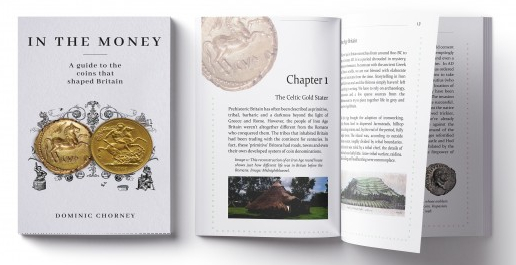
The story of British money in 10 coins - from Celtic Britain to the present.
• Discover the coins behind some of the greatest scandals in British history
• Follow the money: delve into the true power behind the country's strongest leaders
• A foreword by Mark Smith MA, medal specialist and a familiar face on the BBC's Antiques Roadshow
• Over 180 full colour images
• Essential tips and advice on building your collection
• Over 2000 years of history
What do Sir Isaac Newton, Winston Churchill, Henry VIII and the Emperor Hadrian have in common? They have all left a lasting mark on Britain's coins. Miniature monuments of the past, every coin has a story to tell, regardless of its value. Britain has been making money for over 2000 years. From the ancient world of the Celts and Romans to the modern age, the coins we take for granted helped to forge a nation.
Who invented Britannia? What was a 'Bob'? Why was Henry VIII known as 'Old Coppernose'? Presenting over 180 high-quality images of Britain's rarest coins, In The Money is an approachable and accessible guide for any coin collector, enthusiast or historian. Delve into the rich history of money and explore two millennia of the country's most exquisite coins, and the intriguing personalities who helped to create them.
Price £12.99.
Supplies are limited.
For more information, or to order, see:
In The Money - A Guide To The Coins That Shaped
Britain (https://www.baldwin.co.uk/in-the-money-a-guide-to-the-coins-that-shaped-britain.html)
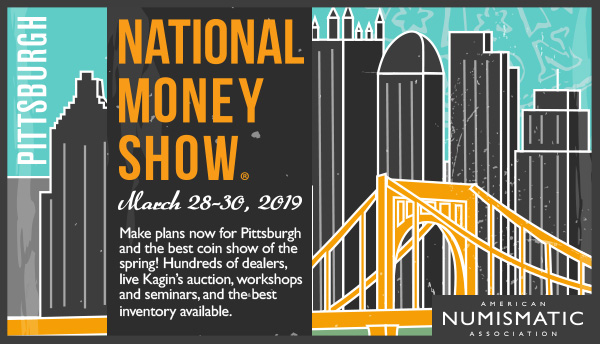
COIN ALBUM CHECK LIST AND VALUE GUIDE AVAILABLE
Dave Lange has published a new Check List and Value Guide for Library of Coins and Treasury of Coins albums. -Editor
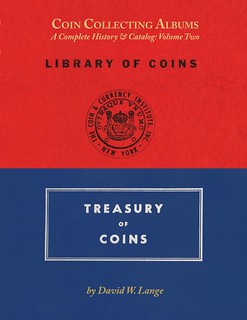 After many requests from collectors and dealers I've created a complete Check List and Value Guide for all
varieties of Library of Coins albums in three grades. Also included in this guide are values for the Treasury of Coins albums, providing complete
pricing information for all items found in my book Coin Collecting Albums: A Complete History and Catalog, Volume Two.
After many requests from collectors and dealers I've created a complete Check List and Value Guide for all
varieties of Library of Coins albums in three grades. Also included in this guide are values for the Treasury of Coins albums, providing complete
pricing information for all items found in my book Coin Collecting Albums: A Complete History and Catalog, Volume Two.
Though this book has been highly acclaimed, many persons were disappointed that it did not include pricing information for these popular, vintage coin albums. That was a conscious decision on my part, as I believed that the market for LOC and TOC albums was too irregular at the time. Publication of my book has changed this enough that discernible patterns have emerged. I'm now able to publish this value guide with confidence that the figures are based on actual, completed sales.
All of the varieties included in Volume Two are given values, and these varieties are keyed to the Lange Numbers in that book for easy reference. In the course of preparing this list I discovered a few errors within the book, so I've updated the 2019 list of additions and revisions that had been sent out a few weeks ago.
Anyone desiring a copy of the Check List and Value Guide, as well as the updated list of additions and revisions for Volume Two, may receive them for free by email in pdf form. Those requiring a hard copy may obtain these by sending a self-addressed and stamped (for two ounces) envelope to my address below.
David W. Lange
POB 110022
Lakewood Ranch, FL 34211
Email: DavidWLange@outlook.com
Web site: http://www.coincollectingboards.com/
NUMISMATIC NEWS EDITOR DAVE HARPER RETIRES
Dave Harper is retiring as editor of Numismatic News. Here's his final column in its entirety. -Editor

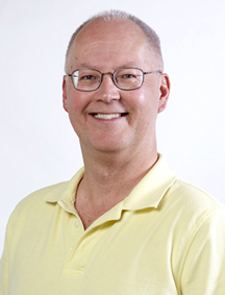 I have retired.
After nearly 41 years working at the Numismatic News office, my chair is now vacant.
I have retired.
After nearly 41 years working at the Numismatic News office, my chair is now vacant.
As I head for the door, I want to say thank you to all readers. I have never forgotten who the average reader is, what his or her interests are, and what news is most likely to help them along their collecting path.
At heart, this is who I have always been. When I first read a copy of Numismatic News 50 years ago, it was because I had picked it up at a coin show. It was the letters to the editor in it that topped my list of favorite things about the paper. I wanted to read more. I immediately sent my money to the firm to get these weekly issues started.
You might say I subscribed because of the letters. The writers seemed like my kind of people. Their questions were my questions. Their opinions were my opinions. They were the kind of people I wanted to hang around with.
I had no idea what I was getting into. Who could?
When I needed a job in 1978, I applied to Numismatic News. Clifford Mishler interviewed me and then phoned me with a job offer. I said yes. Away I went.
I want to thank Cliff for the great opportunity he gave me. Numismatic News founder Chet Krause is no longer alive, but I owe him a great deal as well. Chet and Cliff were the dynamic duo of the firm that was built on the foundation of this paper.
Bank Note Reporter, Coins Magazine, and World Coin News are part of this numismatic family. I had roles in all of them. My first byline appeared in the pages of the June 1971 Coins Magazine.
The numismatic catalog division that created the Standard Catalog of World Coins also birthed North American Coins and Prices and U.S. Coin Digest. I had a role in the creation of the latter two titles, though I really don't consider myself to be a book author.
Always I was part of a numismatic team. It was led for many years by Chet and Cliff. Others followed. We carried on.
Now it is someone else's turn to carry on. It will be up to them to hold high the lamp of numismatic knowledge. I borrow this symbol from the American Numismatic Association, of which I am a life member and enthusiastic supporter.
We collectors are all in this together. We are bonded simultaneously to the past, present, and future. What we do with the present will determine what kind of hobby we leave for the next generation of collectors.
Now I will revert to the status I held 50 years ago: loyal Numismatic News reader. I expect my favorite part of the paper will be letters to the editor written by readers. Taken together, they are the only true guide to our future. I have faith in them. Because I do, I am optimistic about the future. They will make it bright.
To read the complete article, see:
Time to join ranks of loyal readers
(https://www.numismaticnews.net/article/time-to-join-ranks-of-loyal-readers)
Good luck, Dave! We'll miss you. What a great career. I always enjoyed my interactions with Dave, whether by email or in person at some show or panel discussion. Here's a great early photo of Dave shared by reader George Cuhaj. -Editor
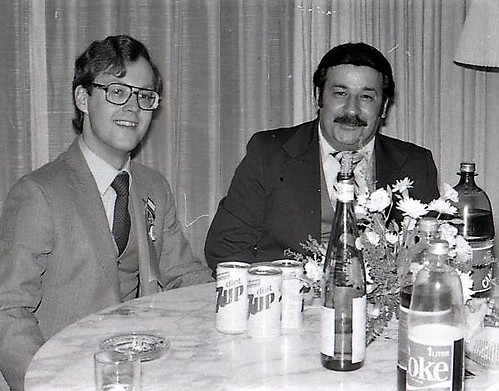
George's caption: Dave Harper and Larry Gentile in the Hospitality room at the 1981 or 1982 Metropolitan NY Numismatic Convention, which was being held at the new Vista International Hotel at the World Trade Center.
As noted in this article by Corinne Zielke, Group Publisher for the Collectibles Division of F+W Media, Dave will remain part of the annual Coin of the Year nomination and judging committee, and may make some "guest appearances" in future issues. See you then, Dave! -Editor
To read the complete article, see:
Viewpoint: Saying Farewell, but not goodbye
(https://www.numismaticnews.net/article/viewpoint-saying-farewell-but-not-goodbye)
NNP ADDS BOWERS & MERENA AUCTION CATALOGS
Good things come to those who wait. We've all been waiting some time hoping for this announcement from the Newman Numismatic Portal. Our prayers have been answered! -Editor
PCGS and Newman Numismatic Portal announce availability of historic Bowers & Merena auction sale catalogs
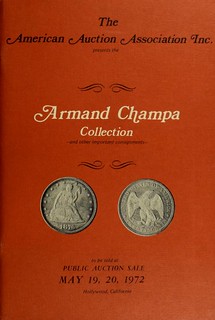
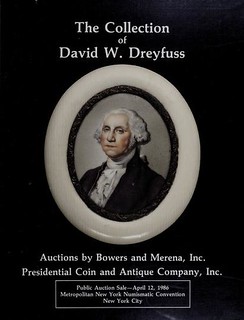
Professional Coin Grading Service (PCGS) and Newman Numismatic Portal (NNP) today announce the full-view availability of Bowers & Merena (and predecessor) auction sale catalogs on NNP. PCGS holds electronic rights to Bowers & Merena publications prior to February 2004, and is making this content available to NNP on a non-exclusive basis. The series consists of approximately 200 auction sale catalogs from 1972 to 2004, featuring legendary collections such as Garrett, Norweb, Eliasberg, and Bass.
The Bowers & Merena auction sale catalogs may be accessed on Newman Portal at https://nnp.wustl.edu/library/auctioncompanydetail/4 .
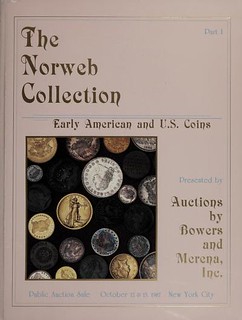
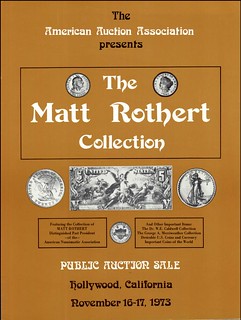
Additional classic publications of Bowers & Merena, including Rare Coin Review, will be added over time. The longstanding "house organ" of Bowers & Merena, Rare Coin Review featured substantive research articles in addition to market updates and fixed price listings of significant coins.
 Brett Charville,
president of PCGS, commented "PCGS has received many requests to make this material available to the collecting community. Collector education is an
important aspect of our business and we are pleased to add this content to the collective memory of our hobby. We welcome continued feedback from the
community and appreciate their input on all aspects of our operation." Q. David Bowers added "I am delighted to see my old company publications made
available on Newman Portal."
Brett Charville,
president of PCGS, commented "PCGS has received many requests to make this material available to the collecting community. Collector education is an
important aspect of our business and we are pleased to add this content to the collective memory of our hobby. We welcome continued feedback from the
community and appreciate their input on all aspects of our operation." Q. David Bowers added "I am delighted to see my old company publications made
available on Newman Portal."
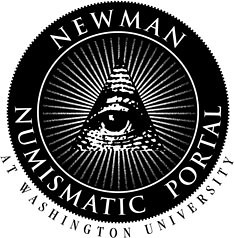 This is an exciting time for numismatic scholarship, and the growth of digital resources is a critical
factor in developing the next generation of coin collectors." Newman Numismatic Portal project coordinator Len Augsburger concluded "We are thrilled
to add these publications to Newman Portal on a full-view basis. Bowers & Merena produced authoritative sale catalogs over an extended period,
and this resource will be of great interest to those researching past sales of many important coins. We are grateful to PCGS for opening this
material to the general public."
This is an exciting time for numismatic scholarship, and the growth of digital resources is a critical
factor in developing the next generation of coin collectors." Newman Numismatic Portal project coordinator Len Augsburger concluded "We are thrilled
to add these publications to Newman Portal on a full-view basis. Bowers & Merena produced authoritative sale catalogs over an extended period,
and this resource will be of great interest to those researching past sales of many important coins. We are grateful to PCGS for opening this
material to the general public."
To visit the full Newman Numismatic Portal, see:
https://nnp.wustl.edu/

SEEKING (BUT NOT FINDING) JOSH TATUM
Paul Schultz submitted these notes on his attempt to track down Josh Tatum of Racketeer Nickel fame. Thanks! -Editor
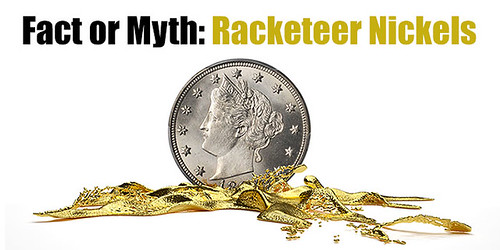
A couple of weeks ago you published a link to the Coin Week article about the legend of Josh Tatum and the No Cents nickel. I decided to look into the plausibility of the story.
I did a search of the 1880 US census for anyone named Josh or Joshua Tatum in Boston. There was nobody even close to that name there at that time. In fact, nobody with a name remotely similar to Josh or Joshua Tatum/Tatem is in any of the northern states in the 1850, 1860, 1870, 1880 or 1900 US censuses. Tennessee has a Joshua Tatum in the first 4 of those censuses, Mississippi has one in 1870, and Alabama has one in 1900. There is one in Louisiana in 1850 who could be the same one as the one from Alabama in 1900. There are no death or cemetery records that I found for a Josh Tatum in northern states in the 1800s. No genealogies on Ancestry.com list a Josh Tatum from the north in the 1800s.
As a broad statement, Tatum is not that common a surname, and most people with that surname in the 1800s are from a southern state. This is not absolute proof that the story is false, but it is circumstantial evidence that the story is rather doubtful. It is plausible that a Josh Tatum went north for a few years in 1881-1885, plated some nickels, and then went back south. Or he might have come from Canada, or England, or some other place and left quickly after the nickel incident. Or the census could have missed him, it is known that censuses are not complete, but missing him 4 or 5 times seems highly unlikely. People obviously did move residences back in those days, but frequent relocations like today were rare.
All in all, I can prove nothing, but based on circumstantial evidence I strongly suspect that the story was a tall tale for the amusement of others. Perhaps it is no coincidence that the original story, from a source in Virginia, came from an area of the country where the surname Tatum is not as unusual.
In addition to the previous data on a Josh Tatum, there is another aspect of the story that raises eyebrows. It states that he made $15,000 before being caught. At a nickel coin being converted illegally to $5, it would require roughly 3,030 nickels to be plated and successfully spent to make $15,000 (including the face value of the nickel, but not counting plating costs). First, apparently not 1 person in over 3000 realized it was a plated new style nickel they were receiving. This seems unlikely. Second, if he walked into a different shop every half hour to spend one, for 8 hours per day, every day, that would be a lot of spending to unload 16 coins per day.
Transportation time between cities is not included here, just time for walking from store to store, as if they were all in a row. At that rate, he would need to spend them every day, 8 hours per day, for 190 days (over 7 months, since stores were closed on Sundays in 1883) to make $15,000. It doesn't seem possible that he could have traveled between many cities and had time to spend enough nickels/$5 coins to profit $15,000 in a few months. And even if the new nickel design were unknown at first, surely at least some people would have become aware of the new nickel before 7 months had passed, and would have caught him sooner. The amount of time it would take to profit by $15,000 questions the credibility of the entire story.
Thanks. This is one of those zombie stories that never dies. Author Lianna Spurrier did a fine job navigating the uncertainties. -Editor
To read the earlier E-Sylum article, see:
LOOSE CHANGE: FEBRUARY 3, 2019
(https://www.coinbooks.org/v22/esylum_v22n05a34.html)
MORE ON THE MUGHAL MULTIPLE-MOHUR COINS
Paul Bosco submitted these thoughts on the Mughal multiple-mohur coins and the copies being offered by Dix Noonan Webb. Thanks! -Editor
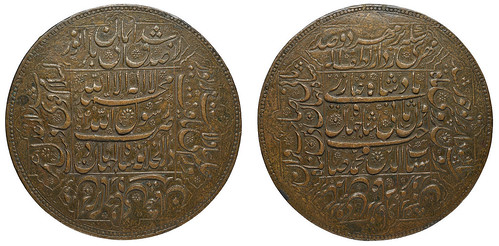
Ignoring the toy coinages of recent years (like the one stolen in Germany...
The 100-mohur or 200-mohur coin, of which an old copy is now up for auction, was the cover coin for one or more editions of the Friedberg catalog of world gold coins. It was noted as a copy in the British Museum of the world's largest gold coin, and it was stated that the actual coin was unknown. I thought it was an electrotype, not a cast (per DNW'S description). I generally read The E-Sylum late Sunday nights, when it is not convenient to do much research. I may be remembering wrong. I also remember the denomination as being 100-mohurs. I don't know that the coin bears a stated denomination, so the weight, not the diameter, would settle the matter.?
In 1987 two coins from the same series were offered by the newly formed auction house Habsburg-Feldman. I was invited by Krause publications to attend a showing, where one could examine the coins minutely in their custom frames, while eating small pieces of fabulous food. Gotta love Krause. There was a 1000-mohur and, if I remember rightly, a 500. The 1000 was something like 8-inches. I considered them the two greatest coins in the world. They were described as previously unknown. They did not sell in the auction, which consisted of only the two coins. They may have changed hands later.
I think the two coins were the ONLY coins Habsburg-Feldman considered worthy enough for them to sell. Feldman was a leading stamp dealer in Switzerland; Habsburg was a bona-fide Habsburg and I think he had been an expert at Sotheby's.
The claim that the piece in DNW is a copy of the world's largest coin is wrong. The (contradictory) representation that 500- and 1000-mohurs were were struck is correct, but the claim that "very few are known" is an understatement; one of each is known.
Interesting! Does anyone know where those coins are today? Here's an excerpt from a 1998 PCGS article by Ed Reiter that Paul found. -Editor
I got a close-up look at a truly incredible coin: a 17th-century gold piece that's roughly 8 inches in diameter and weighs nearly 32 troy pounds - including more than 29 pounds of pure gold. By anybody's yardstick, that's quite a coin! Indeed, it's said to be the largest gold coin ever made.
This minting marvel, a 1,000-mohur coin, was struck in 1613 in Hindustan (present-day northern India) at the direction of a wealthy potentate named Shah Jahangir, possibly as a diplomatic gift. What happened after that remains a mystery. All we really know is that about 11 years ago, the coin - and a smaller companion piece weighing a "mere" three pounds - turned up in the possession of a European auction house which planned to put these treasures under the gavel.
The company, Habsburg, Feldman S.A. of Geneva, Switzerland, calculated that the large piece would fetch about $10 million and the "small" one maybe $4 million, give or take a few hundred thousand dollars.
To read the complete article, see:
Sizing Up The World's Biggest Gold Coin
(https://www.pcgs.com/news/sizing-up-the-worlds-biggest-gold-coin)
To read the earlier E-Sylum article, see:
REPLICAS OF WORLD'S LARGEST COIN OFFERED
(https://www.coinbooks.org/v22/esylum_v22n06a24.html)
NOTES FROM E-SYLUM READERS: FEBRUARY 17, 2019
Buying the the Lutes 1943 Bronze Cent
Tom Caldwell of Northeast Numismatics writes:
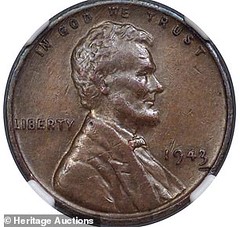 Thanks for running more on Donald Lutes Jr., the recent seller of the 1943 Bronze cent at auction. It is
especially meaningful to me since Northeast was the successful buyer at the sale. Jim Halperin, Mark Borckhart and others from Heritage congratulated
me immediately after it sold.
Thanks for running more on Donald Lutes Jr., the recent seller of the 1943 Bronze cent at auction. It is
especially meaningful to me since Northeast was the successful buyer at the sale. Jim Halperin, Mark Borckhart and others from Heritage congratulated
me immediately after it sold.
Mint error specialist Fred Weinberg did as well saying in his opinion it sold cheap as he expected it to sell for more like $300,000 given the importance of this being the discovery piece and the long term original provenance nature of the piece. I then awkwardly witnessed Fred trying to pay off a bet with Halperin that it would bring in this range.
I don't know why the press referred to the buyer as an "unnamed collector" since Heritage knew Northeast was the buyer. Although I suppose since we are currently not offering the piece for sale I guess that does make us a collector.
The mainstream press often blurs the line between collector and dealer, using the "collector" label indiscriminately. But they often rely on press releases without bothering to follow up to get the details. Since so many buyers wish to remain anonymous, it may be standard practice to not name the buyer - better to be cautious than to out someone accidentally.
Also, I can imagine that any dealer worth his salt would be reluctant to publicize the name of another dealer. Should someone discover another 1943 bronze cent someday and find an old an article on the sale there would only be one dealer name listed - in this case, Heritage Auctions. Now that this E-Sylum article exists a couple other names may appear in their search: Tom Caldwell and Northeast Numismatics. Congratulations on a great purchase. -Editor
To read the earlier E-Sylum article, see:
MORE ON DONALD J. LUTES JR.
(https://www.coinbooks.org/v22/esylum_v22n06a05.html)
Spain 2 Euro Coin With "C A T" Mark
Web site visitor Calogero Saieva writes:
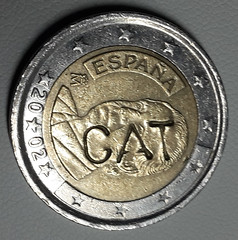 I'm from Agrigento, in the south of Sicily. Some days ago, I found the attached 2 euro coin. It's
a 2002 coin, issued from Spain with the portrait of King Juan Carlos. Engraved on it there are the letters C A T. Never before I saw something like
it. I thought maybe C A T is concise for Catalunya? Maybe someone would be interested on it, and can help me with this strange euro coin.
I'm from Agrigento, in the south of Sicily. Some days ago, I found the attached 2 euro coin. It's
a 2002 coin, issued from Spain with the portrait of King Juan Carlos. Engraved on it there are the letters C A T. Never before I saw something like
it. I thought maybe C A T is concise for Catalunya? Maybe someone would be interested on it, and can help me with this strange euro coin.
I asked Robert Hoge, who writes:
I'm afraid I've never encountered this marking. One might speculate that it could have been applied by Catalan independentistas, but who knows...
Interesting - that was my thought as well. I've never seen one of these either. Can anyone help? -Editor
German Inflation Tokens
Don Kolkman writes:
I thought you might like to see some of the inflation results in Germany on these tokens, a milliarden is equal to our billion.
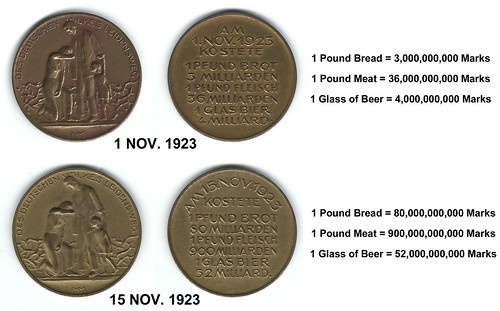
Thanks. I hadn't seen these before. -Editor
To read the earlier E-Sylum article, see:
GERMAN NOTGELD (https://www.coinbooks.org/v22/esylum_v22n06a26.html)
Jim King
I didn't know him, but readers tell me dealer Jim King passed away a week or so ago. -Editor
Paul Bosco writes:
I began buying from Jim while in my early 20s. Among my great numismatic regrets was not buying all his rare Canadian Blacksmith tokens in the mid-1970s. Jim always had rare, interesting material. Nothing seemed to be obscure, to him, in coins, medals and tokens alike. (later, he dealt a lot in Paper Money.) Quite likely, is best area was US Colonial (including Betts medals).
There were two reasons for this: 1) he was really knowledgeable, AND he was smart; and 2) he worked the supply chains in England, where, I would say, he cast American dealers in a very good light.
Jim was also unfailingly nice.
He was still doing shows until a couple years ago.
He and Richard Margolis, two of my models, were very close, and now they are gone, within months of each other.
Alan Weinberg writes:
Jim was in his early 80s A real gentleman of the old numismatic school like his friend and colleague Dick Margolis. They don't make them like that anymore
Query: Ancient Coin Source for 1917 Medal
William Todd writes:
Below is a photo of a 1917 cast iron medal by the Hungarian-born Munich medallist Elisabeth von Esseö (also spelled Essoe, as on this medal) in my collection. The image of these fighting lions is reminiscent of an ancient (Hellenistic?) coin, but thus far my online searches have failed to discover an original which she may have used as a source.
I would be grateful if any reader familiar with Classical numismatics could provide a photo, or link to a photo, of such an image along with relevant data.
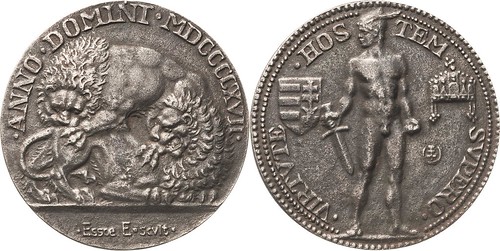
A perfect challenge for E-Sylum readers, the sharpest tacks in the box. Can anyone help? -Editor
U.S. Mint Introduces New Double-Stuf Quarters
Andy Newman, Jeff Rock and Mike Dlugosz forwarded this from The Onion. Thanks! -Editor
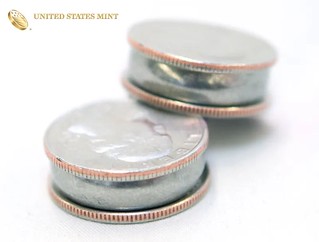
To read the complete article, see:
U.S. Mint Introduces New Double-Stuf QuartersDouble-Stuf
Quarters (https://www.theonion.com/u-s-mint-introduces-new-double-stuf-quarters-1819592058)

B. MAX MEHL MEMORABILIA
Dave Lange submitted this note and images of a small hoard of ephemera published by Texas dealer and master marketer B. Max Mehl. Len Augsburger added the items to the Newman Numismatic Portal as well. Thanks. -Editor
I've never been a big collector of B. Max Mehl memorabilia, since there's so much of it, and very little pertains to my interest in coin boards, folders and albums. He doesn't seem to have been big on stocking anything not published by himself. I do have some early (pre-1920) editions of his guidebooks and also several of his cancelled checks that came onto the market years ago.
Recently, however, I saw an assortment of Mehl items that seem to have been sent to a single individual in the early 1930s. They were extremely colorful and in superb condition, a rarity for numismatic ephemera of that period. The price was quite reasonable, so I had to buy them, and they make a nice little collection in their own right. The radio transcript is from a Mehl radio program broadcast on February 26, 1933, so that provides a pretty reliable time stamp for the other pieces, too.

B. Max Mehl Catalog envelope
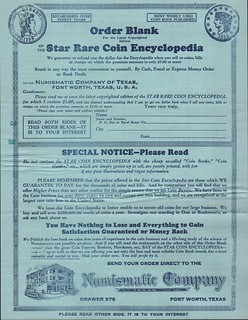
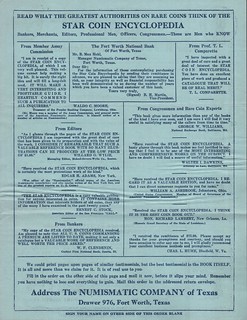
B. Max Mehl Order blank

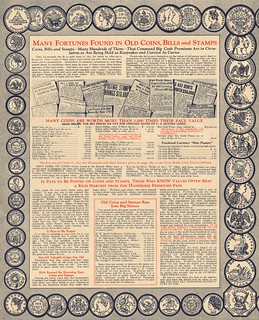
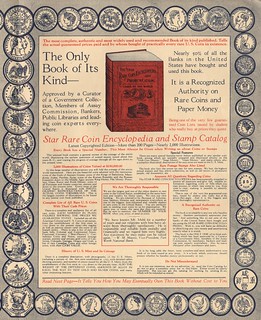
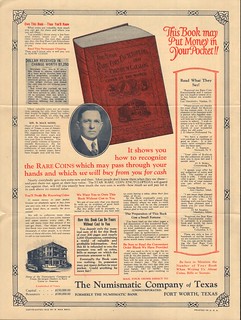
B. Max Mehl 4-page Brochure
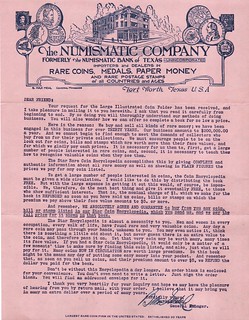

B. Max Mehl Intro Letter, Radio Transcript First Page
Mehl was prolific in his marketing - I also have a number of these items in my numismatic ephemera collection, as do many of our readers, I'm sure. -Editor
To view all the Mehl items on the Newman Numismatic Portal, see:
https://nnp.wustl.edu/library/archivedetail/1353
VOCABULARY TERMS: CHALK AND TRANSFER WAX
Dick Johnson submitted these entries from his Encyclopedia of Coin and Medal Terminology. Thanks!
These are clearly far down in the weeds of the coin and medal-making process, but these details are how the magic actually happens (or did in the days before computers and machines took over). Fascinating reading for anyone who doesn't dismiss it as TMI (too much information). A "How It's Made" style video would be ideal. -Editor
Chinese White. A white powdery material (zinc oxide) made into a liquid and used in engraving to cover a metal surface - as a die or medal - to be marked, scribed or drawn upon prior to engraving. It is also used in painting as a white water color paint. Compare zinc white, precipitated chalk, dye blue.
Precipitated Chalk. A powdered chalk used by an engraver prior to hand engraving a die or medal. The chalk is dusted on the metallic surface allowing the engraver to mark, scribe or draw on the surface. Precipitated chalk is also used with transfer wax to transfer a lettering layout or engraving design to a metallic surface. Compare chinese white, dye blue.
Transfer Wax. Wax in ball or sheet form used by engravers to transfer a drawing, design or lettering to the surface of a die to be hand or machine engraved, or to the surface of a medal to be inscribed. Early engravers made their own transfer wax of ball ground and tallow; now however it is commercially available in modern times. This wax is used with a sheet of gelatin and a chemical toner, called a stain; the procedure is called the wax and stain process.
Transferring a design to a die. Some engravers draw the design and lettering directly on the prepared surface of the die block. This is done by the use of precipitated chalk or Chinese white. Once the center point and set lines are established a cartoon of the design - in exact size - can be drawn on this surface. However this indicates the outline form only (it cannot indicate the modulated relief). If the engraver chooses instead to transfer the design and lettering from a drawing, he can do this by the use of transfer wax and gelatin.
Before the engraver starts he must determine whether he will cut a DIE (in negative) or a hub or cameo die (in positive relief). A hub or cameo die would be engraved with the design and lettering to be right-reading. Cutting a die would require the drawing to be in negative where the entire design would be in mirror image with lettering to be wrong-reading (right to left).
If the drawing is oversize it must first be reduced by pantograph (a drawing pantograph, or camera lucida) to exact image size. Then a sheet of clean clear gelatin is placed over the drawing and is secured to the sheet by pins or paper clips. (If the image of the drawing is not clearly visible through the gelatin, then a colored gelatin sheet is placed between the drawing and the clear gelatin sheet.)
A stylus is used to trace the drawing, lightly scratching the top surface of the gelatin. (An excellent stylus can be made from a phonograph needle stuck in a pencil handle.) The point of the stylus must be rounded but can be as sharp or as fine as the drawing demands. The lines scratched in the gelatin is the image that will be transferred to the steel die surface, thus they can be as fine or as detailed as the engraver desires.
The burrs of gelatin thrown up by the stylus must be removed. This is done with a second piece of the same gelatin (whose edges are slightly harder than the gelatin of the burr); it is used to brush off the burrs. Next clean the steel die block with alcohol; then clean the gelatin sheet with alcohol also (the alcohol must be pure - no impurities). Both surfaces must be clean and free of any grease.
Next the wax is prepared as a resist. Roll the transfer wax between clean hands into a ball. Transfer wax works best at room temperature (if stored next to heat it gets too sticky). Place the wax ball on the scratched surface of the gelatin and roll it back and forth in two directions until an even surface of wax is deposited in the gelatin - but not in the scratched lines.
Then place the gelatin carefully face down into position on the die block, making sure of the centering and any orientation necessary for the design (as on a square die block). Place two drops of oil on the back of the gelatin sheet, not on top of the die block. Then burnish this with a burnisher in both directions, taking care to work the wax onto the surface of the die block. The drawing will show up as unwaxed lines.
The remainder of the die block is then covered with wax - or stop-off lacquer - and then immersed in the stain solution. It etches and applies the black color in less than a minute. Timing is critical as foul biting may occur after 30 seconds or so. The die block is removed and quenched in running water to stop all residual chemical action.
The die block would then be engraved using the design on the face of the die as a design guide. A hub would require cutaway engraving leaving the design and lettering in the positive. Cutting a die would require the engraver to cut the design intaglio into the die for a negative image and lettering. See engraving.
Transferring a design to a medal. For the engraver required to inscribe a medal the wax and stain method can be used, but a more common practice would be to cut the lettering into a sheet of clear plastic (formerly celluloid) and use this as a pattern for his lettering. This later method is beneficial in that he can lay this pattern over the medal, making sure of the spacing of the letters and that all lettering and all lines will indeed fit in the space allowed for it (within the reserve or cartouche).
Looking for the meaning of a numismatic word, or the description of a term? Try the Newman Numismatic Portal's Numismatic Dictionary at: https://nnp.wustl.edu/library/dictionary
Or if you would like a printed copy of the complete Encyclopedia, it is available. There are 1,854 terms, on 678 pages, in The Encyclopedia of Coin and Medal Technology. Even running two a week would require more than 19 years to publish them all. If you would like an advance draft of this vital reference work it may be obtained from the author for your check of $50 sent postpaid. Dick Johnson, 139 Thompson Drive, Torrington, CT 06790.
JOHN CHARLES SCHAYER (1837-1907)
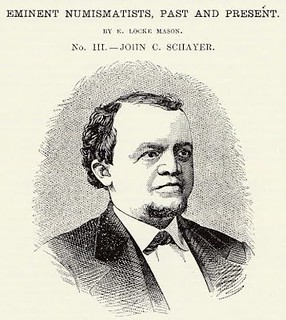 John Charles Schayer
"King of Alligators" (1837-1907), was born at Boston, Massachusetts, son of German immigrant parents, John Schayer, a Boot, Shoe, and
leather tradesman, and Mary A. Schayer.
John Charles Schayer
"King of Alligators" (1837-1907), was born at Boston, Massachusetts, son of German immigrant parents, John Schayer, a Boot, Shoe, and
leather tradesman, and Mary A. Schayer.
On October 30, 1866, he married Ellen C. Ward (1841-1904) in the Catholic Church. They lived at 45 Milk Street, Boston, Massachusetts They had six children : Mary J. Schayer, John J. Schayer, Helen Agnes Schayer, Charles W. Schayer, Clara F. Schayer, George F. Schayer.
He operated a basement store, 68 Devonshire Street, Boston, Massachusetts. The shop had coin cabinets filled with U. S. and foreign coins, and paper money.
 He sold Lorin Gilbert Parmelee (1827-1905) 3,000 U. S.
half cents.
He sold Lorin Gilbert Parmelee (1827-1905) 3,000 U. S.
half cents.
Ebenezer Locke Mason, Jr., purchased from him 200 proof sets 1859-1884.
In 1884, he sold a dozen $50 gold slugs, and $9,000 in early U.S. gold.
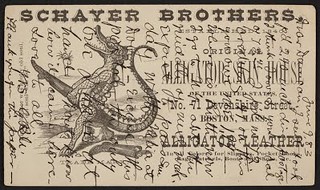
He is listed in "Our Numismatic Directory" List No. 5, No. 100, The Numismatist, Vol. 3, No. 7 & 8, April (1891) : 33
On February 25, 1885 the Schayer Brothers firm went into insolvency.
They moved to Chicago about 1896.
He died December 29, 1907, at Chicago, Illinois.
To read the complete article, see:
SCHAYER, JOHN CHARLES
(https://sites.google.com/a/numismaticmall.com/www/numismaticmall-com/schayer-john-c)
The entire inventory of the Lupia Numismatic Library is for sale. Individual items will be available before the remaining archives are broken up into parcels sold at philatelic auctions in the U. S. and Hong Kong. Check NumismaticMall.com frequently as dozens of new items with estimates will be posted daily until everything is sold.
All inquiries will be given prompt and courteous attention. Write to: john@numismaticmall.com .
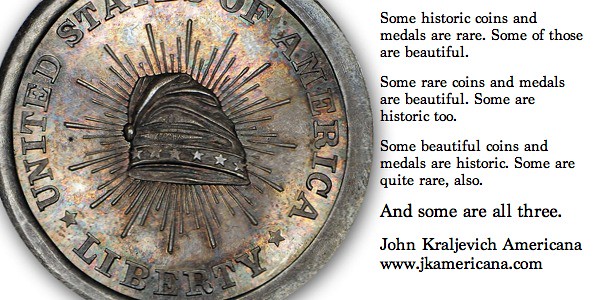
ARTICLE PROFILES DEALER ELIZABETH COGGAN
Dealer Liz Coggan is profiled in this press release published February 13, 2019 on the CDN blog. -Editor
 Liz Coggan
launches a new rare coin firm, Elizabeth Coggan Numismatics, LLC. The company will conduct appraisals, buy and sell rare coins wholesale as well as
help with the acquisition of coins for collectors. Liz's 35 years of experience in the business enables her to offer valued, professional advice
to collectors, estate representatives, lawyers, banks, financial institutions and trust departments to assist with the liquidation of coin, paper
money, gold and silver bullion collections. Liz's negotiation skills and market knowledge will be put to work for you as she suggests the best
avenue for liquidation of your coins for the strongest price. Be that outright sale, consignment, or public auction. Liz is available to collectors
and dealers alike for collaboration and consultation about all numismatic endeavors.
Liz Coggan
launches a new rare coin firm, Elizabeth Coggan Numismatics, LLC. The company will conduct appraisals, buy and sell rare coins wholesale as well as
help with the acquisition of coins for collectors. Liz's 35 years of experience in the business enables her to offer valued, professional advice
to collectors, estate representatives, lawyers, banks, financial institutions and trust departments to assist with the liquidation of coin, paper
money, gold and silver bullion collections. Liz's negotiation skills and market knowledge will be put to work for you as she suggests the best
avenue for liquidation of your coins for the strongest price. Be that outright sale, consignment, or public auction. Liz is available to collectors
and dealers alike for collaboration and consultation about all numismatic endeavors.
Liz Coggan started her career in 1983 working at Bowers and Merena Galleries as executive secretary for Q. David Bowers, one of the world's most preeminent numismatists and prolific numismatic authors. There she learned the ins and outs of the ANA while Bowers was its President. Additionally, she oversaw the advertising for the company before being promoted to the rare coin sales division. In that role she worked with collectors to assemble their collections and built the Want List Program from 25 customers to nearly 1,500 at the time of her departure. Her experiences at the company also included close work and collaboration with Dr. Richard A. Bagg, who was Auction Director at the firm. Under his tutelage and mentorship she learned the important skills of negotiating, obtaining, cataloguing, advertising and selling coins and collections through the public auction venue. Because of these experiences, Liz was able to handle some of the greatest rarities in American numismatics, including the 1894-S Norweb dime (she was given the task of cataloguing the Barber dimes in that storied collection), an 1804 dollar and the 1861 Paquet $20, to name a few.
In 1992 Liz began her 25 year career as Senior Numismatist with J.J. Teaparty, Inc. one of the oldest and most active coin shops in the country until 2012. This store was located off the Freedom trail in Boston, MA, and operated in the same location for nearly 50 years. There she expanded her knowledge of identifying varieties and honing her skills as a numismatic buyer of scare and rare coins for the company inventory, while also selling those pieces to collectors. She attended 20 or so shows per year where she kept her finger on the pulse of market conditions which enhanced her ability to accurately contribute prices to "A Guide Book of United States Coins," referred to as the Bible of numismatics. She began contributing pricing data in 1999 and continues to this day. Liz is the only female price contributor to this illustrious volume. These skills also enabled her to provide accurate appraisals for many banks, law firms, museums and financial institutions throughout Boston and the surrounding area. Through her marriage to store manager and subsequently, co-owner of the firm, Miles Coggan, she learned how to run a retail coin shop and the complexities of trading precious metals.
All of these experiences have prepared Liz for her newest endeavor, the launch of her own rare coin firm, Elizabeth Coggan Numismatics, LLC DBA Liz Coggan Rare Coins. The same integrity, fairness, trustworthiness and personal care, you experienced when you worked with her at Bowers and Merena Galleries and J.J. Teaparty, Inc., is available to you once again.
If you would like her assistance and expertise with your collecting endeavors, need an appraisal for an estate, want her help with selling your collection for the highest possible price, or just want to reconnect with her, she welcomes your email at liz@lizcoggan.com. If your prefer you can call or text Liz at 508-513-8383.
To read the complete article, see:
Longtime Coin Expert Launches Elizabeth
Coggan Numismatics (http://blog.greysheet.com/expert-stacks-bowers-executive-launches-elizabeth-coggan-numismatics/)
2019 NATIONAL MONEY SHOW WELCOME BANQUET
The 2019 ANA National Money Show is coming up next month in Pittsburgh. The Pennsylvania Association of Numismatists (PAN) is the host club, and they're hosting a banquet dinner welcoming show attendees on Wednesday March 27th. Here's some information. PAN puts on a fantastic event - the restaurant is top-notch, and the view is amazing. -Editor
 It is the pleasure of the Pennsylvania Association of Numismatists (PAN) to invite you to
attend an enjoyable evening of great food, music and numismatic company at one of Pittsburgh's premiere restaurants, the LeMont. It is situated
atop Mt. Washington and offers a dynamic view of the city of Pittsburgh.
It is the pleasure of the Pennsylvania Association of Numismatists (PAN) to invite you to
attend an enjoyable evening of great food, music and numismatic company at one of Pittsburgh's premiere restaurants, the LeMont. It is situated
atop Mt. Washington and offers a dynamic view of the city of Pittsburgh.
PAN is honored to host the 2019 American Numismatic Association National Money Show. We have arranged a very special evening as a welcome event for those attending the NMS coin show. Guest speaker will be U.S. Mint Director David Ryder.
Members, non-members, friends, and family are all invited. Please go to the PAN website www.PANcoins.org and order your meal selections online. There are no tickets issued. Your name and party will be on the guest list and name cards. We can reserve tables of 8 if you organize a group.
PAN is celebrating 40 years of serving numismatists. If you would like to become a Ruby Patron please donate $40. We will list your name or business in the banquet program book.
This is a great opportunity to hear and meet the Mint Director himself and other numismatic luminaries. I'm planning to attend. Please join me, and we can reserve a table for E-Sylum readers and Numismatic Bibliomania Society members. Contact me at whomren@gmail.com if you'd like to share a table. Order before March 10th to save $10. That's the cost of the shuttle bus, so order now and get a free ride. -Editor
To reserve your space, see:
https://pancoins.org/
SS CENTRAL AMERICA CASH BOX FINDS
Attendees of talks by Bob Evans in recent months saw a preview of finds from the purser's safe recovered on the most recent expedition to the wreck of the S.S. Central America. The official press release came out this week. What an amazing find! -Editor
Historic silver and gold coins discovered in the purser's lock box in 2014 from the fabled "Ship of Gold," the S.S. Central America that sank in 1857, are coming to market for collectors, according to the California Gold Marketing Group LLC (CGMG) of Brea, California.
"Two bags found in the purser's box contained a combined total of $1,588.95 face value of U.S. coins from silver dimes to Half Eagle $5 gold coins, and ranged in dates from 1796 to 1857," revealed CGMG Managing Partner Dwight Manley. "Most of the coins are dimes that were to be used in daily commerce while the ship sailed between Panama and New York City before sinking in a hurricane off the North Carolina coast in September 1857."

This photo taken in 2014 shows some of the more than 8,000 U.S. dimes, still wet from the bottom of the Atlantic Ocean, just after they were recovered from a safe on the S.S. Central America that sank in 1857. (Photo courtesy of California Gold Marketing Group.)
One of the dimes is an 1838-O that was overstruck at the New Orleans Mint with dies intended for an 1842-O quarter. Manley said the "35-cent" error coin is not for sale, but will be publicly exhibited. It apparently circulated for 15 years before becoming sunken treasure with the other coins now recovered from the S.S. Central America.
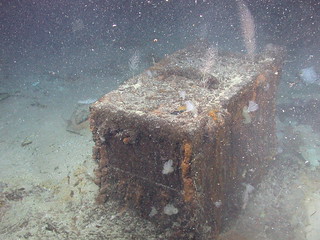 The well-preserved silver coins discovered in the purser's sealed iron box are being carefully examined,
cataloged and certified by Professional Coin Grading Service (www.PCGS.com).
The well-preserved silver coins discovered in the purser's sealed iron box are being carefully examined,
cataloged and certified by Professional Coin Grading Service (www.PCGS.com).
"One of the recovered canvas bags at the bottom of the box was about the size of a volleyball and it contained thousands upon thousands of dimes. It quickly became obvious that this was the 'cash box' of the ship, a truly marvelous historical find," said Bob Evans, the chief scientist on the 1980's mission that first located and recovered a portion of the fabulous sunken treasure and who served in that same role and as a numismatist with the 2014 recovery.
"The purser's bags, one with dimes and another with primarily silver quarter dollars and half dollars, were inside a box we found in a corner of the safe that was on its side when we found it. The box was flimsy, and it collapsed when we attempted to move it with our remote-controlled, spatula-like tool over 7,000 feet deep under water. There were other contents of the safe including some paper artifacts and a pistol," Evans revealed.
The purser's bag contained 8,873 U.S. dimes, 503 quarters, 345 half dollars, and a smaller bag inside the large one contained 55 gold dollars, 56 Quarter Eagles and 41 Half Eagles. Additional gold and silver coins, perhaps brought onboard by S.S. Central America passengers, were found elsewhere in the safe for a combined total of 9,877 coins.
"The dimes in the purser's bag survived 157 years in the Atlantic Ocean without the corrosion seen on most silver coins found on shipwrecks. This is undoubtedly due to the oxygen-starved (anaerobic) conditions within the safe, creating a deep-sea time capsule," explained Evans. "The safe was not water tight, but it essentially sealed off the interior environment and its chemistry from the outside seabed environment. The result was that even the canvas bag holding these coins did not degrade significantly," explained Evans.

Universal Coin & Bullion of Beaumont, Texas (www.UniversalCoin.com) now is selling many of these recovered silver coins. For additional information, call 800-822-4653.
The SS Central America was a 280-foot long, three-masted side-wheel steamship carrying tons of California gold that had been shipped from San Francisco to Panama when she sank on September 12, 1857 hurricane during the final leg of a voyage from Aspinwall (now Colón), Panama to New York City. The loss of the ship's gold cargo was a major factor in the economically devastating financial panic of 1857 in the United States.
"These coins found in the purser's safe made up the working money of the ship. The sailors of the labor class were paid one to three dimes a day. Remember that in 1857 the S.S. Central America was on its 44th voyage to Panama and back since its launching in November 1853. This was a well-established business, and here we get to look at the life-blood of that business, its working capital. It is fascinating to see everything that was in circulation in 1857, including some bent, pierced and heavily worn coins," said Evans.
"Some of these could have been used as 'magic charms.' If it weighed something close to a tenth of an ounce, it passed in circulation as a dime," he explained.
In a court-approved transaction in November 2017, the California Gold Marketing Group acquired all the treasure recovered in 2014 from Ira Owen Kane, Receiver for Recovery Limited Partnership and Columbus Exploration, LLC. In 1999, CGMG acquired all of the available S.S. Central America treasure that was recovered in the 1980s.
"One-by-one examination and certification of the coins recovered in 2014 began in January 2018. Virtually all of the 3,129 federal, private mint and world gold coins that were retrieved in 2014 now have been sold. The silver coins from the purser's safe are the final items curated and are now coming to market," said Manley.
A complete list of all the items recovered in 2014 will be published in an upcoming book, America's Greatest Treasure Ship: The S.S. Central America, by esteemed numismatic author Q. David Bowers and Manley.
We'll look forward to the book! -Editor
To read an earlier E-Sylum article, see:
ARTICLE HIGHLIGHTS BOB EVANS' RETURN TO THE SS CENTRAL AMERICA
(https://www.coinbooks.org/esylum_v17n19a25.html)

EXPERT-LEVEL U.S. MEDALS CHALLENGE
Jonathan Brecher submitted this tough challenge for our readers. Thanks. Who can crack the puzzle? -Editor
I think that anyone short of an expert will have a hard time answering more than one or two of these questions. But we've got some experts here! Let's see how folks do, or if I've come up with a stumper. :-)
I'm showing the wreaths on the reverses of four different US medals. Three of these I've had for a while; the fourth one is a new purchase. And a jaw-dropper of a purchase also - but for reasons that are not exactly related to this challenge and that I'll reveal afterwards. For now, give this a shot:
1. Besides obvious trivial details (They're all round! They're all silver! They all have wreaths on them!), what do the four medals have in common? [difficult]
2. Identify each medal:
* A (30.5 mm): [difficult]
* B (30.5 mm): [expert-plus]
* C (36.1 mm): [expert]
* D (36.1 mm): [expert-plus]

Mystery medal A reverse
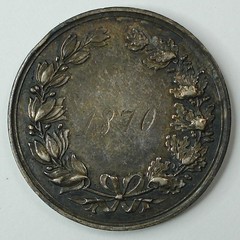
Mystery medal B reverse
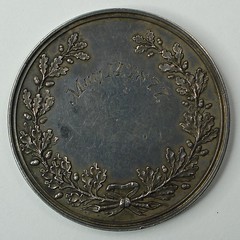
Mystery medal C reverse
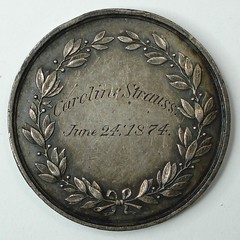
Mystery medal D reverse
Now that's tough. But if anyone can do it, it's an E-Sylum reader. What say you? -Editor
NUMISMATIC NUGGETS: FEBRUARY 17, 2019
Here's a selection of interesting or unusual items I came across in the marketplace this week. Tell us what you think of some of these. -Editor
British Charitable Music Society Medal
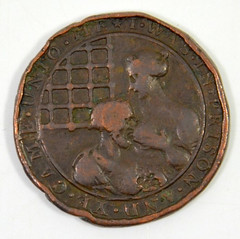
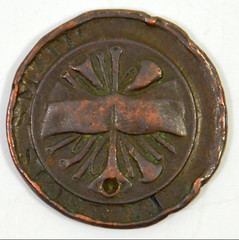
British Medals, Charitable Music Society, 'I was in Prison and Ye Came unto Me', bronze, mid 18th century, 33mm
A beat-up but intriguing medal. -Editor
To read the complete lot description, see:
BRITISH
MEDALS, CHARITABLE MUSIC SOCIETY
(https://www.the-saleroom.com/en-gb/auction-catalogues/kingham-and-orme/catalogue-id-kingha10016/lot-b744ce38-1b03-4264-98d4-a9f5011f1c47)
1878 Panorama De Paris Balloon Medal
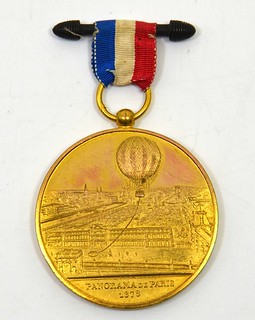
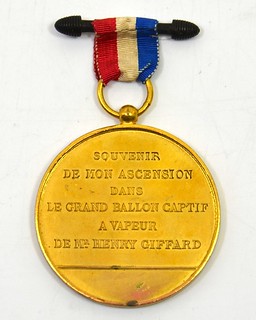
World Medals, France, `Panorama De Paris 1878` and `Souvenir De Mon Ascension Dans Le Grand Balloon Captif a Vapeur De Mr Henry Giffard`, gilt bronze, circa 1878 (C. Trotin), 51mm
I have a soft spot for ballooning medals. Ever ridden in a hot air balloon? I did it back in my single days, and it was a great experience. Put it on your bucket list and give it a try. Once after I married and our kids were young, a balloon appeared above our neighborhood, floated down our street, and safely landed in a field across the main road. It was a magic surprise. -Editor
To read the complete lot description, see:
WORLD
MEDALS, FRANCE, `PANORAMA DE PARIS 1878'
(https://www.the-saleroom.com/en-gb/auction-catalogues/kingham-and-orme/catalogue-id-kingha10016/lot-bdf99664-f6ee-474f-8391-a9f5011f58eb)
1892 Columbian Half Dollar "Opium Coin"

1892 Columbian Half Dollar "Opium Coin".
These box coins are sometimes called "opium coins" because they allegedly were used to smuggle or store opium for their owners. This may be true in
some rare cases, but more frequently they were used to house photos or other keepsakes of loved ones. But calling it an Opium Coin sounds way cooler.
$250.
From Dave Wnuck's email newsletter Making the Grade #41, published February 13, 2019. -Editor
Lou Gehrig's Elks Membership Medal
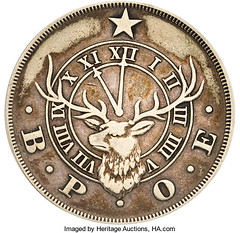
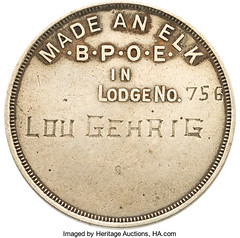
Approximately the size of a half-dollar coin (1.25" diameter), this historic token commemorated the acceptance of the Hall of Fame first baseman into the brotherhood of the New Rochelle, NY lodge of the Elks. Obverse features the insignia of the organization, while verso is engraved with Gehrig's name and the number (756) of the chapter in his hometown. Fine condition with no condition issues of note. Letter of provenance from consignor.
From the February 23-24 Heritage sports auction. Great item! -Editor
To read the complete lot description, see:
1920's Benevolent & Protective Order of Elks Membership Coin from The Lou Gehrig Collection...
(https://sports.ha.com/itm/baseball-collectibles/others/1920-s-benevolent-and-protective-order-of-elks-membership-coin-from-the-lou-gehrig-collection/a/50011-80444.s)
WAYNE'S NUMISMATIC DIARY: FEBRUARY 17, 2019
Tuesday February 12, 2019 was the meeting night of my monthly Northern Virginia numismatic social group Nummis Nova. Steve Bishop was our host, and we met at a restaurant named The Espositos in Fairfax. Member Joe Esposito was absent, and so were the jokes about the restaurant connection (there is none).
Several folks were already there when I arrived, including Steve, Mike Packard, Jon Radel, Robert Hoppensteadt, Tom Kays and Dave Schenkman. Julian Leidman arrived shortly after me. It was a smaller group than normal, with some being kept home by wintry weather. Wayne Herndon was at the Fairfax Coin Club meeting.
So-Called Half Dollars
I took a seat across from Steve and next to Dave Schenkman, who showed me a fascinating sample set of so-called half dollars. The group of ten pieces
shows the various finishes available.


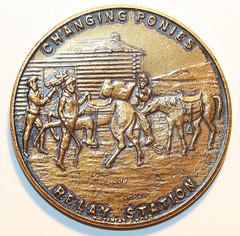

1935 Pony Express Diamond Jubilee medal sample
So what is "Tumbled Ormolu"? This is a fascinating set, which was probably used as a salesman's sample when taking orders for other medals. Has anyone seen anything like this before?
Obsolete Paper Money
Dave also brought some interesting recently purchased obsolete paper money, beginning with an amazing odd denomination from the Eric P. Newman
collection.

Fascinating piece, worth two and a half bits. Payable at three stores in three cities as well as on board Lake Champlain Steam Boats, those were likely the towns where the boats docked. I haven't consulted a map, though.

A much more common denomination - one bit was worth twelve and a half cents.
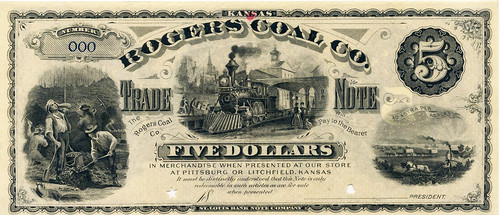
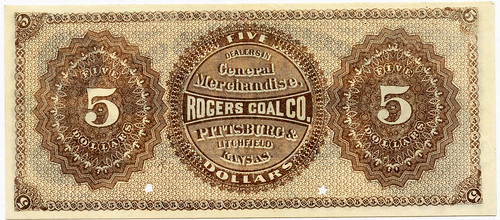
A very rare coal company note that brought spirited bidding. Congrats on all your acquisitions, Dave!
Russian Reoverstrikes and Pattern Copies
Steve Bishop brought some interesting Russian pieces. He writes:
The 1791 and 1796 pieces are rarer dates of Paul's reoverstriking of 1797, which are usually found dated 1793. The two 1809 pieces are modern copies of extremely rare pattern pieces.
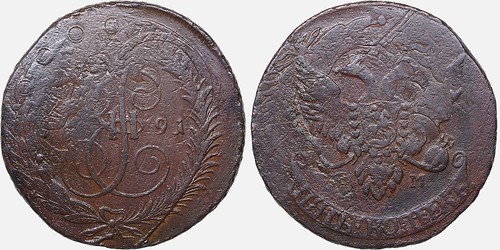
1791 EM 5K Reoverstriking
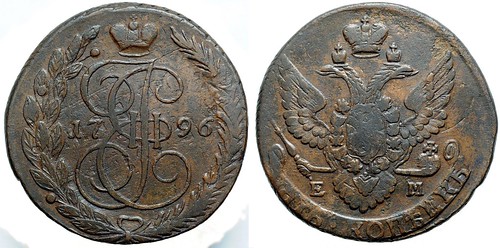
1796 EM 5K Reoverstriking
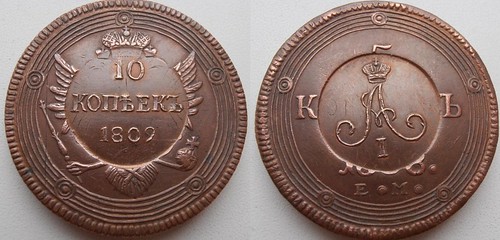
1809 10K Pattern Copy
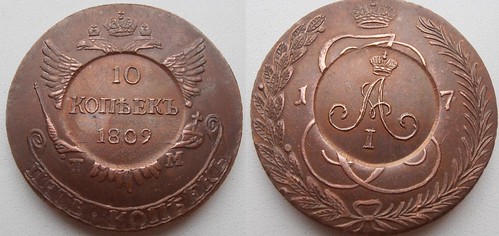
1809 10K Pattern Copy
Damnatio Memoriae
Robert Hoppensteadt passed around an interesting ancient medallion.
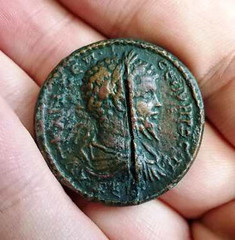
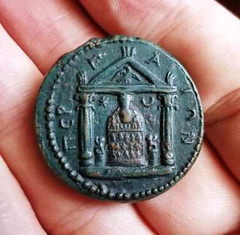
Robert writes:
This is an AE34 medallion from Perga weighing 40 grams. Exceptionally detailed reverse picturing the cult image of Artemis in a distyle temple, sphinxes to either side eagle in pediment. The obverse is nice too but this fell into the hands of someone who was not a fan of Septimius Severus in antiquity. Cutting or defacing the image of an emperor was called Damnatio Memoriae and was sometimes official though not for this emperor.
To read an earlier E-Sylum article, see:
FEATURED WEB PAGE: DAMNATIO MEMORIAE
(https://www.coinbooks.org/esylum_v16n14a27.html)
It was another great evening of numisamtic fellowship. I'm already looking forward to our next meeting.

HEATON MINT SPECIMEN 5 CENT
A Stack's Bowers Galleries blog article by Kyle Ponterio published February 14, 2019 describes a great Heaton mint specimen to be offered in the March 2019 Stack's Bowers and Ponterio Hong Kong Auction. -Editor
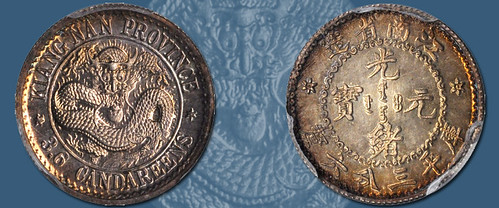
This week's featured highlight is a condition census example of a historically important issue from Kiangnan, struck at the Heaton Mint: Lot 60199 - Specimen 3.6 Candareens (5 Cents), ND (1897).
Commissioned in 1897, the Heaton Mint produced a series of six coins, five silver and one brass, as proposed patterns or trial strikes of the eventual adopted design for the Nanking Mint. A full set of dies and a small number of proofs were sent along with the minting equipment after completion. Upon arrival, the Nanking Mint began production using the supplied dies and other equipment.
The familiar design of the first struck series issued from the Nanking mint consists of an encircled dragon with outer legends "KIANG NAN PROVINCE" and "3.6 CANDAREENS" separated by six-pointed stars as stops. The reverse displays the central inscription "光緖元寶" (Guāngxù yuánbǎo [Valuable Coin {of the} Kuang Hsu {era}]) with Manchu inscription in the very center meaning the same thing, all within a linked "S" border, top inscription "江南省造" (Jiāngnán shěng zào [Made in Jiangnan Province]) and bottom inscription "库平三分六釐" (Kù píng sān fēn liù lí [Indicating value by weight as Ku'ping 3 Cadareens 6 Li]). Each side displays an interesting curved denticle border near the rim.
This is a highly sought after and collected issue, especially as a specimen with a needle sharp strike, frosted devices and smooth flashy surfaces. Enhancing the appeal is a lovely combination of mottled pale rose and golden patina. Nearly flawless, this piece is tied with two other examples in this grade at either NGC or PCGS, with none finer. The chance to acquire such a magnificent example may not occur again for many years.
To read the complete article, see:
Superb Gem Specimen 5 Cent to be Offered in the Stack's Bowers and
Ponterio Hong Kong Auction (https://www.stacksbowers.com/News/Pages/Blogs.aspx?ArticleID=3286)
1937 "REEDED EDGE" NICKEL AND CENT
This is also from Dave Wnuck's email newsletter Making the Grade #41, published February 13, 2019, and republished here with permission. Thanks! -Editor
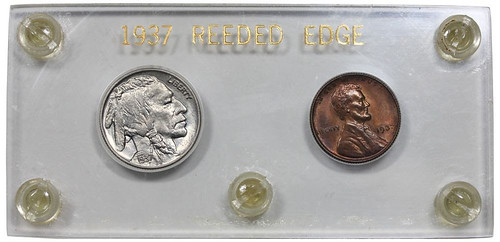
1937 "Reeded Edge" Buffalo Nickel & Wheat Cent. Uncirculated [uncertified].
I have read articles about these coins, but never owned any until now. The story goes that these coins had their edges reeded outside the Mint by
Pennsylvania coin dealer Ira Reed, intended as a promotional gimmick to advertise his business at the 1941 ANA Convention in Philadelphia. It is
thought that about 100 sets were prepared. Housed in a customer Capital Plastics holder. Heritage auctioned one of these 2 coin sets for $1997.50 in
June of 2016. This pair in a custom holder is just $1350.
To read Dave's newsletter archive, see:
http://www.davewcoins.com/newsletter
The REEDed edge cent had been mentioned earlier in The E-Sylum, but this is the first image we've had. Nice holder. Does anyone have new information on these coins? What's the best documented source? -Editor
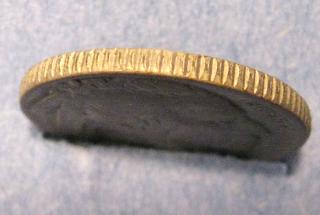 To read
earlier E-Sylum articles, see:
To read
earlier E-Sylum articles, see:
REED'S REEDED NICKELS (https://www.coinbooks.org/esylum_v05n13a09.html)
REEDED CENTS (https://www.coinbooks.org/esylum_v05n14a08.html)
QUERY: REEDED EDGE IRA REED NICKELS
(https://www.coinbooks.org/esylum_v13n04a13.html)
THIRTY-SIXTH ANNUAL COIN OF THE YEAR AWARDS
Tom Michael of Numismatic News published a February 15, 2019 article about the recent Coin of the Year (COTY) awards. -Editor
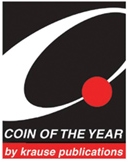 Our Thirty-Sixth
Annual Coin of the Year Awards Ceremony took place Feb. 2 in Berlin at the World Money Fair.
Our Thirty-Sixth
Annual Coin of the Year Awards Ceremony took place Feb. 2 in Berlin at the World Money Fair.
From the thousands of coins produced in a year, only a hundred make the cut for nomination.
These 100 are then sorted by category for our Judges Panel to consider. Out of 10 category winners, one is chosen for overall COTY honors.
To open the COTY ceremony this year, we had remarks from both of our sponsors: the World Money Fair, represented by Gitta Künker, Managing Director of the World Money Fair Holding GmbH, and Michael Chou, Publisher of the Journal of East Asian Numismatics.
The United States Mint returned to the World Money Fair this year to accept two COTY awards. New director David J. Ryder is a true "coin guy" who plans to push his staff in innovative ways in years to come. He explained this from the podium as he accepted the award for Best Gold Coin for the 100 Dollar Gold American Liberty 225th Anniversary coin. Truly gracious in design, this coin stood out for both its unique depiction of Liberty and its classic image of an eagle in flight. The second award for the United States went to the silver Dollar Boys Town Centennial Commemorative, a perfect design for commemoration, for which it won the Most Inspirational Coin category. Ronald Harrigal, a 30+ year member of the U.S. Mint, joined Ryder at the podium for this acceptance.
Seethe complete article online for more information and images of several winners. Here are a few that caught my eye in addition to the American Liberty 225th Anniversary Gold Coin. -Editor
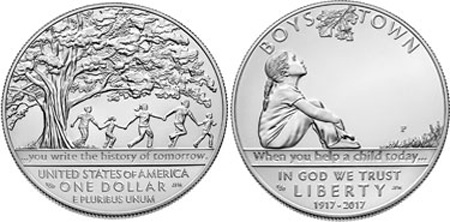
Most Inspirational Coin - United States Mint - 1 Dollar, Silver - Boys Town Centennial Commemorative
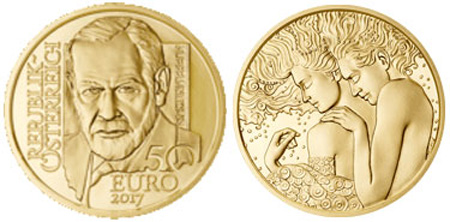
Most Artistic Coin - Austrian Mint - 50 Euro, Gold - The Vienna Schools of Psychotherapy - Sigmund Freud

Most Innovative Coin - Republic of Palau - 20 Dollars, Silver - Great Micromosaic Passion - Birth of Venus
To read the complete article, see:
Coin of the Year awards given in Berlin
(https://www.numismaticnews.net/article/coin-of-the-year-awards-given-in-berlin)
This World Coin News article is a compilation of photos of the recipients of the Coin of the Year awards. -Editor
To read the complete article, see: Award recipients from COTY's anticipated awards presentation at the World Money Fair in Berlin (https://world.mintnewsblog.com/2019/02/award-recipients-from-cotys-anticipated-awards-presentation-at-the-world-money-fair-in-berlin/)

LOWELL NATIONAL HISTORICAL PARK QUARTER LAUNCH
I missed the press release somehow, but CoinNews.net published a piece on February 11, 2019 about the launch ceremony for the Lowell National Historical Park quarter. VERY impressive crowd! -Editor
 On Wednesday, Feb. 6, quarters celebrating Lowell National Historical Park in
Massachusetts were officially introduced to the public.
On Wednesday, Feb. 6, quarters celebrating Lowell National Historical Park in
Massachusetts were officially introduced to the public.
A crowd of more than 2,600 people, including about 1,700 schoolchildren, attended the launch ceremony hosted by officials from the National Park Service and United States Mint. Kids aged 18 and under received a free Lowell quarter to commemorate the event.
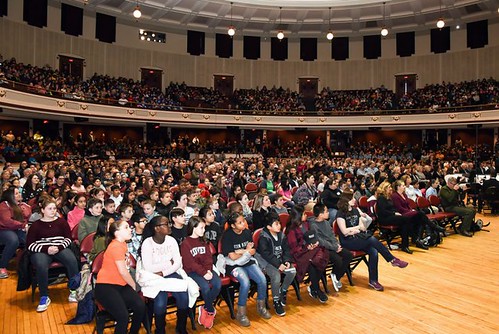
Depicted on the quarter's reverse (tails side) is a scene emblematic of the historical park - a mill girl working at a power loom with its prominent circular bobbin battery and a view through the window of Lowell's Boott Mill clock tower.
"The depiction of the mill girl takes us back to the past at the forefront of America's Industrial Revolution," remarked Marc Landry, the Mint's Acting Associate Director for the Numismatic and Bullion Directorate. "The physical coin takes us to present day manufacturing processes; and finally, the coin in its entirety takes us into the future - inspiring tomorrow's innovators, workforce, and generations to follow."
Landy shared the stage with former Congresswoman Niki Tsongas, Chancellor of University of Massachusetts Lowell Jacqueline Moloney, Executive Director Yun-Ju Choi of Coalition for a Better Acre, Chief Executive Officer Karen Frederick of Community Teamwork, Inc., Lowell City Manager Eileen Donoghue, National Park Service Regional Deputy Director Rose Fennell, and park superintendent Celeste Bernardo.
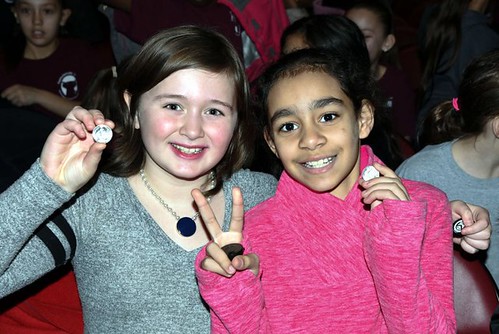
To read the complete article, see:
Lowell Quarter Launch Ceremony Highlights
(http://www.coinnews.net/2019/02/11/lowell-quarter-launch-ceremony-highlights/)
PITTSBURGH AMUSEMENT PARK TOKEN HEADS TO MOON
Rich Bottles forwarded this short article about a token that's heading to the Moon. Thanks. -Editor
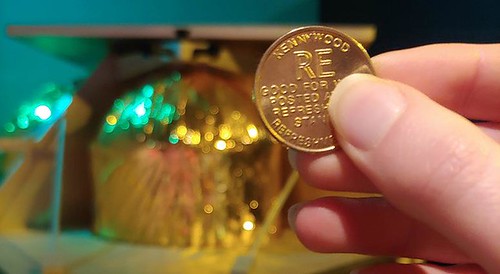
After more than 20,000 votes in the Heinz History Center's #MoonBox campaign, a token from Kennywood Park has been selected to be sent to the Moon.
The token will travel to the moon as part of Strip District-based company Astrobotic's first commercial Moon landing in 2021.
The token garnered a total of 51 percent of the vote, beating out 7 other contenders.
A micro SD card with the theme song to Mister Rogers' Neighborhood on it came in second with 14 percent and a write-in campaign for a teeny tiny Smiley Cookie finished with 9 percent.
Other items on the list were a Heinz pickle pin, soil from Moon Park in Moon Township, a piece of a Pittsburgh Steelers Terrible Towel, a photo of Toni Haggerty of Primanti Bros., and a City of Pittsburgh flag pin.
"We're over the Moon about the opportunity to represent Pittsburgh in outer space, and we thank the History Center and Astrobotic for making this happen!" said Kennywood General Manager Jerome Gibas. "This Kennywood token doesn't have an expiration date, so if it ever makes its way back to Earth, it can be used to buy some of our world-famous Potato Patch fries!"
The #MoonBox campaign celebrates the final weekend of Destination Moon: The Apollo Mission exhibition. It ends on President's Day, February 18.
Raise your hand if you know what a Heinz Pickle Pin is. Bonus points for knowing its connection to the 1893 Chicago World's Fair.
As a native Pittsburgher, I grew up on annual outings to Kennywood. And as someone who worked for years in the city's high-tech industry, it's great to see a startup company involved in commercial Moon travel. -Editor
To read the complete article, see:
Kennywood Token To Soon Call The Moon Home
(https://kdkaradio.radio.com/articles/kennywood-token-soon-call-moon-home)
For more information about Kennywood Park, see:
Kennywood (https://en.wikipedia.org/wiki/Kennywood)
https://www.kennywood.com/
To read about the Heinz Pickle Pin, see:
The Story of the Pickle Pin
(http://www.picklesburgh.com/story-of-the-heinz-pickle-pin/)
PHIL MICKELSON'S SILVER DOLLAR BALL MARKER
For the golf fans among us, here's a story from the Golf News Network about Phil Mickelson's favorite ball marker - a silver dollar owned by his grandfather. Unfortunately, the coin isn't illustrated. -Editor
Phil Mickelson almost always uses the same ball marker when he plays golf. He uses a replica silver dollar on the greens at every tournament he plays, except when he plays at Pebble Beach Golf Links and in the AT&T Pebble Beach Pro-Am.
When Mickelson plays golf at Pebble Beach and on the tournament's rotation through the Monterey peninsula, he doesn't use the usual replica silver dollar. Instead, Mickelson uses a genuine silver dollar his grandfather held for many years. You see, Mickelson's grandfather, Al Santos, was in the crop of original caddies at Pebble Beach, which opened for play in 1919 and celebrates its 100th anniversary in 2019.
Santos, who was 9 or 10 years old when he started working at Pebble Beach, was tipped the silver dollar after one of his loops. He kept it instead of spending it, occasionally rubbing it with his fingers because it made him feel richer and better off than he was at the time. He wished for a better life for his family. Eventually, Mickelson got a hold of the silver dollar, and he uses it specifically at Pebble Beach in an emotional connection to one of golf's most special places.
"There's a few things that within our family that go back to this place where my grandfather grew up here and he was one of the original caddies in the caddie group," Mickelson said. "And he would go around here for 25, 30 cents a loop. And when we would talk about this place and what it meant to him growing up, and so there's an emotional tie to this place. I don't think it has anything to do with why I've played well here in the past, but you never know, it's just I always enjoy coming here."
To read the complete article, see:
https://thegolfnewsnet.com/golfnewsnetteam/2019/02/12/heres-why-phil-mickelson-uses-a-silver-dollar-as-a-ball-marker-112391/
(https://thegolfnewsnet.com/golfnewsnetteam/2019/02/12/heres-why-phil-mickelson-uses-a-silver-dollar-as-a-ball-marker-112391/)
SPRING VALLEY ILLINOIS NATIONAL BANK NOTE
It's nice to see mainstream news outlets covering numismatic topics. sometimes we cringe at the reporters mistakes, but it's all good publicity for the hobby. Here's an item from the Illinois News Tribune. See the complete article online for great information on the history of the issuing bank. -Editor
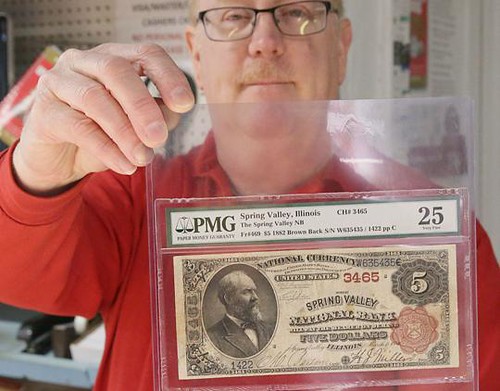 They found it at an auction in Florida about 1,000 miles and 130 years removed from its origin in the
Illinois Valley.
They found it at an auction in Florida about 1,000 miles and 130 years removed from its origin in the
Illinois Valley.
But the $5 Spring Valley National Bank note is back in Spring Valley sitting sealed in plastic and nestled safely in the confines of Valley-Coin-Jewelry-Pawn.
"If it could talk," said owner Chris Drewel. "It's been spent. It's been folded in people's wallets."
The 1882 series "Brown Back" is one of only two known to exist in the world right now, Drewel said. The Drewel family, which operates the Valley pawn shop, learned of the notes' existence a few years ago.
"We'd heard about them about two or three years ago and thought, 'Boy, that'd be something neat to have,'" Drewel said. "We learned that there were two out there. One was in New Jersey and one was in California."
And when the Drewels saw one up for grabs at the Florida United Numismatists show in Orlando last month, they went for it. And they won it.
"There was some fierce bidding," Drewel said. "It's like the Lombardi Trophy coming home to Green Bay."
To read the complete article, see:
Collectors
find rare Spring Valley bank note, one of two known to exist
(http://www.newstrib.com/news/collectors-find-rare-spring-valley-bank-note-one-of-two/article_024f2aec-2fd2-11e9-a544-e36ed6e909c2.html#1)
DOLLAR BILL ALTERED INTO A $100
This report from a Massachusetts news outlet illustrates a $1 bill altered into a counterfeit $100. -Editor
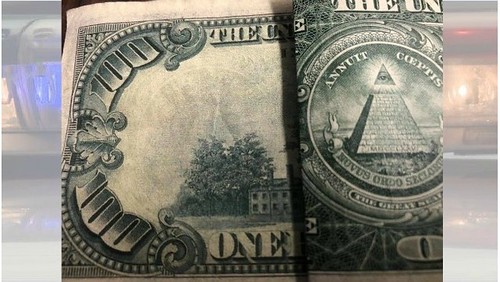
Freetown police are warning people to watch out for counterfeit bills after a phony $100 bill turned up at a local bank.
Police said the counterfeit money was actually a $1 bill made to look like a $100 bill.
Since the bill is still made of banknote paper, police warned businesses that counterfeit detector pens would show the phony $100 to be real money.
To read the complete article, see:
$1 bill transformed
into $100 bill turns up at Freetown bank
(https://www.wpri.com/news/local-news/se-mass/-1-bill-transformed-into-100-bill-turns-up-at-freetown-bank/1775712582)
VALENTINE'S DAY WITH BANKNOTE BOUQUETS
This florist in Bali has found a niche selling banknote bouquets. -Editor

It's official. Flowers and Ferrero Rocher are yesterday's news. The new black? Banknote bouquets, of course.
Bali resident I Made Wira Astika started his small floristry business last year, crafting bouquets of flowers to sell from his home in Kerobokan, according to local-language media outlet, Nusa Bali.
But this Valentine's Day, the crafty Casanova noticed an emerging trend for bouquets of a different type - that's when he began making them out of money.
The demand has apparently been so good that Astika has ditched conventional bunches of flowers altogether. And "good," according to the source, amounts to about 20 orders per day around the busy Valentine's Day period.
The price of each bouquet varies depending on the denomination of the preferred banknotes. Most people apparently opt to use IDR2,000 (US$0.14) or IDR5,000 (US$0.35), but some splash out with IDR100,000 notes (US$7.10), said Astika, who charges IDR65,000 (US$4.61) arrangement fee per item.
"They [customers] pay us with cash. But we exchange their money first at the bank so that the notes are fresh," he told Nusa Bali.
Astika's most expensive creation to date was priced at IDR4,000,000 (about US$284), and was crafted from 40 red bank notes.
Cut out the middleman! Why buy flowers when you can just give away your money instead? -Editor
To read the complete article, see:
Bali florist cashes in on
Valentine's Day with banknote bouquets
ART FROM VENEZUELAN BANKNOTES
Found via the February 12, 2019 issue of News & Notes from the Society of Paper Money Collectors (SPMC) is this latest report on artworks created from worthless Venezuelan banknotes. -Editor
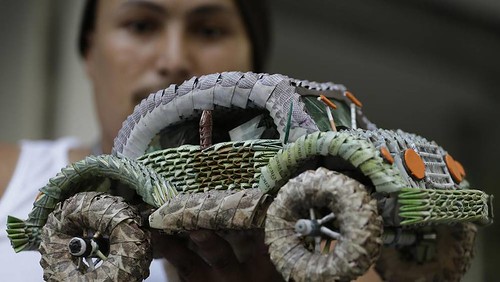
Venezuelan migrants in Colombia are giving their devalued currency a new lease of life by recycling near-worthless bolivars into artworks.
Food and job shortages have spurred more than three million Venezuelans to emigrate since 2015.
But migrants from the country in the Colombian city of Cucuta have tapped into their creative power to make a living by folding notes into model cars, swans, handbags and purses. The handicrafts are then sold on stalls at a significant markup from the bolivar's black market value.
Venezuela's rate of inflation reached 2,000,000 per cent in 2018 following economic measures by socialist President Nicolas Maduro...
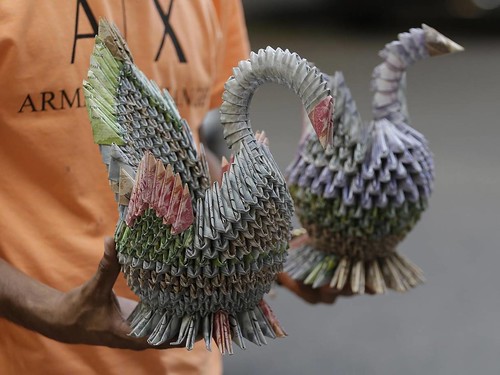
To read the complete article, see:
Venezuelans make
art from banknotes in bid to give them value
(https://www.independent.co.uk/news/world/americas/venezuela-crisis-migrants-origami-currency-colombia-cucuta-border-a8775166.html)
To read the earlier E-Sylum articles, see:
VENEZUELA CRAFTSMEN USE WORTHLESS BANKNOTES
(https://www.coinbooks.org/v21/esylum_v21n07a31.html)
VENEZUELA'S WORTHLESS BANKNOTES
(https://www.coinbooks.org/v21/esylum_v21n29a34.html)
THE ART OF BOOK COVERS
For the pure bibliophiles among us, here's an article from The Public Domain Review. Great collection. -Editor
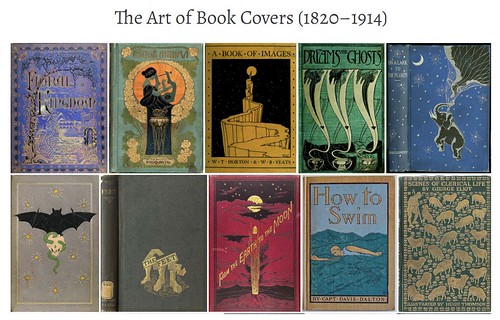
Inspired by rising literacy rates and advancing technologies, the nineteenth century saw the book transform from a largely hand-made object to a mass-produced product. In this new environment the book cover took on added importance: it was no longer merely a functional protection for the pages but instead became a key platform through which to communicate and sell the book.
Prior to this covers had - bar a smattering of highly bespoke one-off creations (e.g. embroidered covers for personal libraries) - mostly been plain leather bound affairs. From the 1820s, with the rise of mechanical bookbinding, these leather covers of old gave way to new cloth coverings which, in addition to being inexpensive, were now also printable.
A wide variety of cover printing techniques were employed over the decades: from embossing to gilt to multi-colour lithography. A totally new artistic space was opened up. As you can see in our highlights below it was one in which illustrators and designers flourished, producing a range of covers as eclectic in aesthetic approach as the myriad contents they fronted.
How about numismatic book covers? What are your favorites? This compilation stops at 1920, but all are fair game right up to the present. -Editor
To read the complete article, see:
The Art of Book Covers (1820-1914)
(https://publicdomainreview.org/collections/the-art-of-book-covers-1820-1914/)
Check out the PDR web site for interesting artiles on a wide variety of topics. I also enjoyed The Tomb and the Telephone Box: Soane's Mausoleum (1816) (https://publicdomainreview.org/collections/the-tomb-and-the-telephone-box-soanes-mausoleum-1816/) and The Dancing Plague of 1518 (https://publicdomainreview.org/2018/07/10/the-dancing-plague-of-1518/) -Editor
Founded in 2011, the PDR is an online journal and not-for-profit project dedicated to the exploration of curious and compelling works from the history of art, literature, and ideas.
As our name suggests, the focus is on works which have now fallen into the public domain, that vast commons of out-of-copyright material that everyone is free to enjoy, share, and build upon without restriction.
To read the complete article, see:
https://publicdomainreview.org/
LOOSE CHANGE: FEBRUARY 17, 2019
Here are some additional items I came across in the media this week that may be of interest. -Editor
Late Roman Reverse Types
On February 12, 2019 Numismatic Guaranty Corporation (NGC) published a nicely illustrated article on Late Roman Reverse Types. See the complete article online for MUCH more. -Editor
It's worth keeping in mind that these columns illustrate only a small percentage of reverse designs created at the mints of the Roman Empire.
We'll start with some basic types associated with the Roman army and its victories. Below are four billon coins depicting the Roman goddess Victory.
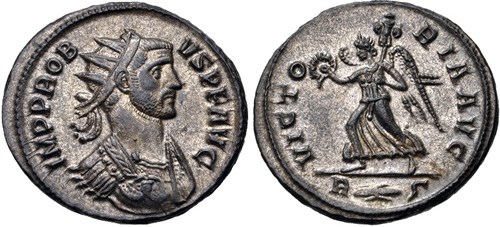
To read the complete article, see:
NGC Ancients: Late Roman Reverse Types - Part One
(https://www.ngccoin.com/news/article/7178/ancient-roman-coins/)
McCulloch Wax Portrait by William Barber
A wax portrait of Treasury Secretary Hugh McCulloch believed to be by U.S. Mint Chief Engraver William Barber is discussed in this February 14, 2019 Coin World article by Pul Gilkes. -Editor
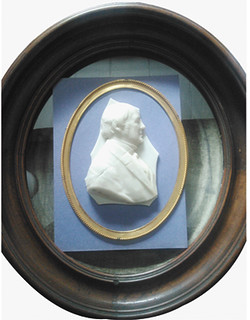 The wax portrait is of the
nation's first comptroller of the currency, Hugh McCulloch, who later served as Treasury secretary in the administrations of Presidents Abraham
Lincoln and Andrew Johnson, from March 9, 1865, through March 9, 1869, and again at the close of President Chester A. Arthur' term, in 1884 and
1885.
The wax portrait is of the
nation's first comptroller of the currency, Hugh McCulloch, who later served as Treasury secretary in the administrations of Presidents Abraham
Lincoln and Andrew Johnson, from March 9, 1865, through March 9, 1869, and again at the close of President Chester A. Arthur' term, in 1884 and
1885.
The Feb. 6 auction by the auction firm in Randolph, Maine, was an estate sale of items consigned by McCulloch's heirs, which had been removed from the Gardiner, Maine, property previously owned by the McCulloch family.
To read the complete article, see:
Wax portrait work of U.S. Mint Chief
Engraver William Barber (https://www.coinworld.com/news/us-coins/2019/02/william-barber-wax-portrait-in-main-auction.html)
Is That A Real-Fake or a Fake-Fake?
This Coin World article by Art Friedberg discusses the thorny problem of telling the difference between a genuine Banksy Di-faced Tenner and lookalike copies. -Editor
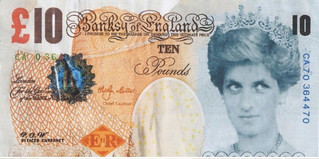 Tom Hockenhull, the museum's curator of modern money, had been trying to acquire one for years to add
to its collection of parody notes, but he kept on running into the real fake versus fake fake issue. Finally, he encountered a donor close enough to
the artist that he could trust the provenance - the artist's sales representative, an entity known as Pest Control.
Tom Hockenhull, the museum's curator of modern money, had been trying to acquire one for years to add
to its collection of parody notes, but he kept on running into the real fake versus fake fake issue. Finally, he encountered a donor close enough to
the artist that he could trust the provenance - the artist's sales representative, an entity known as Pest Control.
To read the complete article, see:
British Museum
collection obtains Banksy '£10 note
(https://www.coinworld.com/news/paper-money/2019/02/the-british-museum-collection-obtains-a-banksy-10-note-art.html)
To read the earlier E-Sylum article, see:
BRITISH MUSEUM ACQUIRES BANKSY £10 NOTE
(https://www.coinbooks.org/v22/esylum_v22n05a33.html)
Video: Florida Father-Daughter Coin Dealers
Joshua McMorrow-Hernandez of CDN Publishing interviewed coin dealers John and Alex Zieman in this video published February 15, 2019. Check it out. -Editor
John and Alexandrea Zieman aren't your typical coin dealers. This dynamic father-daughter duo work out of their weekend storefront, Z-Man's Coins, at a Brooksville, Florida, shopping center, and their lucky star never seems to go dim. Some of the most impressive finds walk into their shop, including two authentic 1943 bronze cents and the personal family collection of historic relics from the family of Robert Patterson, a Philadelphian who served as a United States Mint director in the early 1800s.
More recently, they made a tremendous - and long-awaited - discovery at the Florida United Numismatists 2019 Convention, where they found a rare, early coin slab. It was at the 2019 FUN Show in Orlando in January 2019 where I caught up with these two noteworthy coin experts for a fun chat about rare coins, numismatic passions, and their desire to spread the love of the hobby to the next generation.
To read the complete article, see:
Father-Daughter Coin
Dealers In Florida Spread Love Of Numismatics To The Next Generation
(http://blog.greysheet.com/father-daughter-coin-dealers-in-florida-spread-love-of-numismatics-to-the-next-generation/)
Los Angeles: The Last Bookstore

More than a few bibliophiles would prefer that their prized possessions be kept in a bank vault as opposed to a bookshelf, but few actually get to see their dream in action.
Enter The Last Bookstore, an iconic LA bookstore with a not-so-subtly symbolic name housed in the grand atrium of what was once a bank.
The marble pillars and mile-high ceiling remain from the old bank, but in place of patrons and guarded stacks of cash, bookshelves line the walls and artful displays of books abound.
To read the complete article, see:
The Last Bookstore (https://www.atlasobscura.com/places/last-bookstore)
KIDS TODAY: WHAT IS CASH?
"What is this 'cash' thing you speak of?" The Wall Street Journal published a front-page article last weekend about how today's kids have little experience with good old fashioned coins and paper money. -Editor
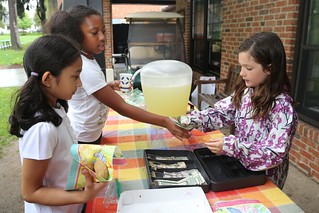 Ralph Pantozzi, a math teacher in Summit, N.J., said his school's lemonade stand sometimes
puzzles some of the third-graders who run it. It isn't usually the math, or dealing with customers, that stumps them.
Ralph Pantozzi, a math teacher in Summit, N.J., said his school's lemonade stand sometimes
puzzles some of the third-graders who run it. It isn't usually the math, or dealing with customers, that stumps them.
It's the hard currency.
"We see them with their cash register and they're picking up the money and I know they look at it sort of 'what do I do with this?,' " he said. "They're really not used to it."
Teaching youngsters the value of dollars and cents is a task that has vexed parents for generations. Now parents face a new challenge: delivering the lesson in a world where children rarely encounter actual money.
Retailers notice bewilderment when young customers come into their stores armed with the paper money they have been given for holidays or a birthday. "Sometimes the kids that are given cash, even the idea that it's not a gift card is completely foreign," said Gaetana Schueckler, who has owned The TreeHouse Toy Store in Buffalo, N.Y., since 1996.
For years, one of its top sellers was a toy cash register. The store doesn't even carry them anymore, since "for kids, it's not something they see," said Ms. Schueckler.
I'm not so sure, but the article's last paragraph may hold out some hope for numismatics in the cashless future.
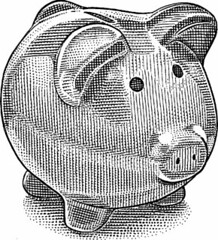 "She tucks that
money away into her piggy bank and she has a disconnect in terms of how that money then turns into the purchasing of goods, because we then buy
mostly everything online or via a credit card," said Ms. Noel, who lives in Los Angeles. "It's more like a collectible item."
"She tucks that
money away into her piggy bank and she has a disconnect in terms of how that money then turns into the purchasing of goods, because we then buy
mostly everything online or via a credit card," said Ms. Noel, who lives in Los Angeles. "It's more like a collectible item."
To read the complete article (subscription required), see:
The First Money
Lesson to Teach Your Children: This Is What a Dollar Looks Like
(https://www.wsj.com/articles/the-first-money-lesson-to-teach-your-children-this-is-what-a-dollar-looks-like-11549657256)

